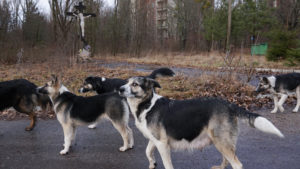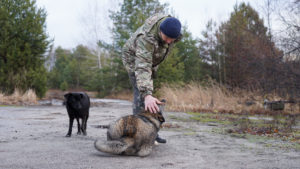Riding a train home in Den Haag, the Netherlands, I wondered whether I could ask my partner this question or not: “What happened to Robin? And the stick insects?” It felt uncomfortable, inappropriate. The lives of animals were not the top priority, I thought, when her younger brother and sister were rushed out of Kyiv to Germany due to Russia’s invasion of Ukraine only weeks ago.
Recently, I was asked to write an article about how nonhuman animals are affected by Russia’s invasion of, and subsequent war crimes in, Ukraine. As the publication offered payment, I agreed, passing on the fee to Ukrainian grassroots humanitarian organisations. Since I was writing the article, it felt okay to ask the question on my mind. The response: “Of course they took them!”
Robin is a parrot. He is the beloved companion of Andrii (aged ten) and Masha (aged five). He can say several words in Russian. He perches on my hand when I visit for dinner. The flutter of his wings sounds like a helicopter when he zooms between rooms.
A week into Russia’s invasion of Ukraine, Andrii and Masha were driven by their mother and father overnight from Kyiv to Vinnytsia, and then west to a city in Zakarpattia Oblast on the western side of the Carpathian Mountains. From there, they travelled to Germany to their mother’s friend’s house; a friend she met during state-organised trips to Germany for families of affected or displaced by the Chornobyl nuclear catastrophe of 1986. Andrii and Masha’s grandparents had lived in Pripyat before the disaster. They’ve had to evacuate their home for a second time. Aged under 60, Andrii and Masha’s father must legally remain in Ukraine in case of conscription.
Of course, they didn’t leave Robin behind, nor their bunny (Freddy), nor Robin’s recently acquired parrot companion, Fanny. This was unthinkable to Andrii and Masha. Unfortunately, however, two of their stick insects died while travelling from Kyiv, and, in the busyness of evacuating, one was left in their apartment.
****
I can’t help but relate this story to the fieldwork I’ve been conducting in the Chornobyl Exclusion Zone for the last three years. In 2019, I moved to Kyiv to spend time with scientists studying radiation’s effects on nature, to work with an NGO caring for the Zone’s free-roaming dogs, and to make a film.
After the nuclear catastrophe of 26 April 1986, residents within a 30km exclusion zone were evacuated, including Andrii and Masha’s grandparents. During evacuation, evacuees were instructed to leave companion animals behind, setting out enough food and water to sustain them during their absence. Most trusted the authorities who said they would return within a few days. The promise of return, however, was quickly revoked. Having consumed what was left behind, the animals were forced to roam the Zone in search of companionship, food, and water.
Believing these dogs were contaminated, Soviet soldiers killed them to prevent the spread of radiation to uncontaminated places outside the Zone. Consequently, hundreds of dogs were shot and buried at Chornobyl. Soldiers were unable to kill every dog, though. The sound of gunfire terrified the animals who fled to the forest. The dogs that survived faced a harsh new reality. Abandoned and without humans, they confronted predating wolves, a lack of food, and radiation itself.
Today, however, the Chornobyl Exclusion Zone is home to around 550 dogs, descendants of those abandoned in 1986. These dogs live in small packs at checkpoints and settlements around the Zone where they are fed, sheltered, and cared for by workers (Figure 1).
In February 2022, Russian invaders moved from Belarus – a Russian-controlled country bordering Ukraine’s north – into Ukraine and quickly occupied the Chornobyl Nuclear Power Plant (ChNPP). ChNPP workers are held hostage and have only recently rotated shifts. The Russian occupation of Chornobyl poses great threats not only to the workers, but also to international security. As of April 2022, the Chornobyl Exclusion Zone has been liberated from Russian invaders.
Recent reports from the Clean Futures Fund (CFF) – an NGO that runs spay/neuter, vaccination, and feeding campaigns to care for Chornobyl’s dogs – suggest that a group of 70 dogs living by the ChNPP have migrated to places where Ukrainian workers provide them with food (Figure 2). The CFF’s operations are on hold during the Russian invasion, but will resume when the occupiers retreat. In the meantime, they are providing humanitarian support to those affected by the invasion in Slavutych, the town where ChNPP workers live, and are attempting to provide food for the dogs.
****
Across Ukraine today, animals are abandoned en masse as residents of cities, towns, and villages pack their bags and flee Russian aggression as fast as humanly possible. As of 30 March 2022, around four million people have left to neighbouring countries, with another 6.5 million internally displaced. Consequently, companion animals are suffering a similar fate to those abandoned in 1986 as Russian atrocities and war crimes relentlessly continue.
Amidst these atrocities, however, brave civilians are risking their lives to find and support abandoned animals. The Kyiv Animal Rescue Group, ZooPatrol, UA Animals and ‘I want to live’, for instance, gather information on abandoned pets and rescue them from crumbling homes damaged by Russian bombs. Tetiana Kotanova, who works for Kyiv Animal rescue Group, told me that “when people look at the suffering of animals, it causes them additional suffering.” My friend Katya, who evacuated to Germany, tells me her mother remains in Kyiv and refuses to leave as she can’t take her cat. I’ve heard several stories like this, which testify to the strength of human-animal bonds. Tetiana added, “our attitudes towards animals reflect the maturity of society. In times of suffering, it’s very important to preserve humanity.”
Since the war began, stories of ‘animal heroes’ have proliferated across social media, including a dog who detects mines and a puppy born on the frontline who can apparently recognise the sound of Russian bombs. Images and videos of human heroes go viral, too: Ukrainian soldiers rescuing cats and dogs from rubble, residents of besieged cities evacuating disabled dogs, and terrified cats being rescued from trees by civilians. Stepan the cat from Kharkiv, who has 1.2 million Instagram followers, went viral on TikTok while being evacuated to France. Using Stepan’s feline fame, his owner raised over £7,000 for charities supporting animals during the war. As Catherine Wanner writes, Ukrainians “are winning the battle for our hearts and minds.” The plight of animals during wartime pulls especially hard on the heart strings of many.
****
For those fleeing with pets, a major worry was not being able to cross the border with their companion animals. Travelling with animals can be a complicated process. To prevent the spread of rabies, many countries have policies in place that require animals to be vaccinated and microchipped, and to have a passport. Some require costly quarantine periods. Puppies adopted out of Chornobyl by the CFF, for instance, must spend three months in quarantine before being transported across the Atlantic.
At the start of the war, as millions of people fled to Western Europe, Instagram was abuzz with information regarding border crossings that were or were not allowing the safe passage of more-than-human families. Indeed, families were deciding where to leave according to where was likely to accept their undocumented animal companions. Today, certain countries, including Italy, Finland, Romania, and Poland, have waived restrictions for microchipping, vaccines, and other requirements for Ukrainians. This shift in biosecurity policy is an implicit recognition of the importance of nonhuman animals to humans and their families. The question remains open as to whether these policy changes represent a recognition of the needs and desires of animals themselves. What it does show, though, is that human and nonhuman animals are entangled; mutually reliant on each other for a sense of safety and security.
Once emigrated, Ukrainian refugees are able to receive support from animal welfare organisations like Four Paws International in their host countries. Several organisations are working with groups to provide services for evacuated animals, like vaccination and microchipping.
****
Russia’s war in Ukraine is also “having a drastic effect on the nation’s zoos.” While lions, tigers, and other animals have been relocated to zoos in Poland, this is not possible for many species. Several of Ukraine’s largest zoos – including Mykolaiv, Kyiv, and Kharkiv zoos – have been attacked by Russian invaders, and evacuation is extremely risky. Zoos contain dead and starving animals – some have even been spotted roaming the streets – and others are given sedatives to cope with the stress of bombardment. Aid is difficult to deliver, but like Katya’s mother, many zookeepers remain. As does the Ukrainian Nature Conservation Group which oversees a third of Ukraine’s protected areas that are now in active war zones.
****
What happened to Robin? Asking questions like this can be difficult, awkward. My own discomfort in asking it points to the type and extent of hospitality I’m apparently willing to extend to nonhumans. For many, though, it is an important question. And the answer is part of making sense of Russia’s war in Ukraine.
When, why, and how do companion animals become an object of concern in contexts of war, mass human suffering, and displacement? I have two preliminary hunches that require further scholarly attention at a more appropriate time. First, the sustained attention and support Ukraine is receiving from international (especially western) publics involves – rightly so – an understanding of Ukraine as the innocent victim of Russian aggression. Within this, animals are problematically labelled with an innocence above civilians as part of a lightly-veiled misanthropic discourse. Second, in relation to the waiving of biosecurity policies, elevated hospitality towards Ukraine’s nonhuman refugees, again problematically, seems entangled with notions of Ukraine as a European, familiar country. Such hospitality is not always afforded or supported to humans and their companion animals.
The human tragedy of this atrocious war increases daily. We should not equate the human and nonhuman experience of war – such interspecies comparisons are unhelpful, serving neither humans nor animals. Instead, we should recognise the power and importance of human-animal relationships. That Ukrainians and supportive charities afford care to animals right now is not only brave, but highlights the more-than-human destruction that all wars wreak.
About the author: Jonathon Turnbull is a geographer at the University of Cambridge who researches the dogs of Chornobyl and the scientific controversy surrounding the return of nature to the Zone. For the last three years, he has been a visiting researcher at the National University of Kyiv-Mohyla Academy and lived in Kyiv from where he made regular trips to Chornobyl. He Tweets @jonnyjjt.
This blog is part of the forum: Making sense of the war in Ukraine

